
Source: Galaxy; Compiled by Deng Tong, Bitchain Vision
Preface
In 2024, there has been a huge shift in Bitcoin and digital assets.In 2024, new products, record inflows, huge policy shifts, increasing popularity and Bitcoin’s position as an institutional asset were consolidated.
There are two major advances this year: the launch of spot-based Bitcoin ETP in the United States, and the election of Donald Trump as a second non-sequential presidency.Between these events, the market has been in a volatile, indecisive horizontal consolidation for 237 days.While these events are both a catalyst and a backdrop for the market in 2024, the breadth and narrative of the market will expand in 2025.Back to the topic, here are some Galaxy Research’s predictions for 2025.
Bitcoin
1. Bitcoin will exceed $150,000 in the first half of the year and may reach a maximum of $185,000 in the fourth quarter of 2025.The combination of institutional, corporate and national adoption will drive Bitcoin to new heights in 2025.Since its existence, Bitcoin has appreciated faster than all other asset classes, notably the S&P 500 and gold, a trend that will continue in 2025.Bitcoin will also account for 20% of gold’s market value.
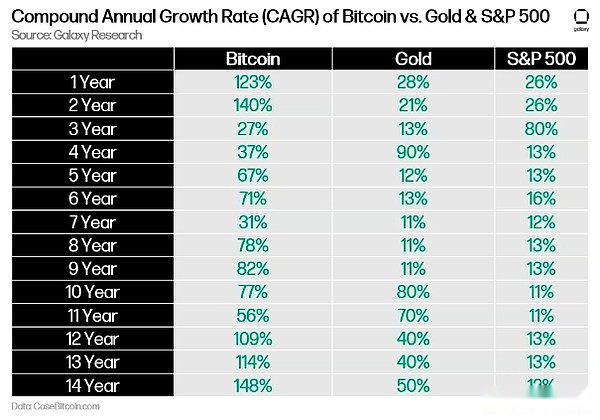
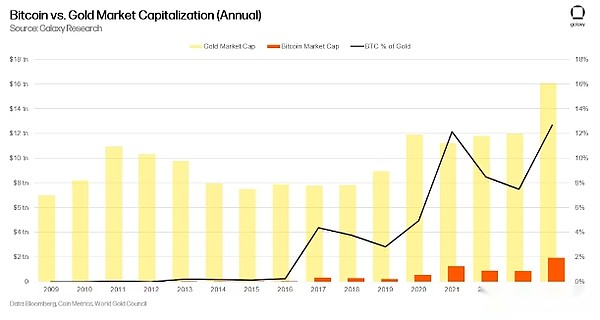
2. By 2025, the total asset size of US spot Bitcoin ETP will exceed US$250 billion.In 2024, Bitcoin ETP absorbed a total of more than US$36 billion in net inflows, becoming the largest issuance ETP in history.13F documents show that many major hedge funds in the world have purchased Bitcoin exchange-traded products, including Millennium, Tudor and D.E. Shaw, while the Wisconsin Investment Commission (SWIB) has also purchased Bitcoin exchange-traded products.Just one year later, the asset size of Bitcoin exchange-traded products (ETFs) is only 19% (US$24 billion) away from the asset size of all physical gold exchange-traded products in the United States.
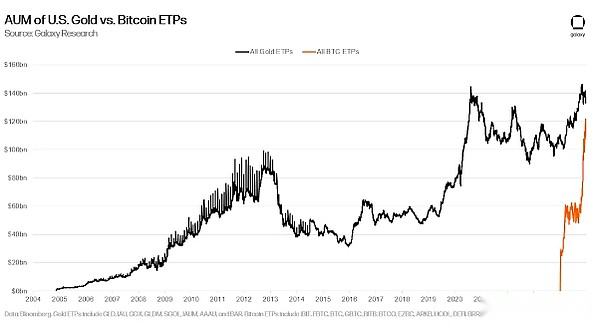
3. By 2025, Bitcoin will once again become one of the best risk-adjusted assets in the global assets.The above AUM comparison is due to record inflows in 2024 and rising Bitcoin prices.In fact, Bitcoin is the third most risk-adjusted asset.It is worth noting that the best Sharpe ratio belongs to MicroStrategy, a company that calls itself a “bitcoin finance company.”
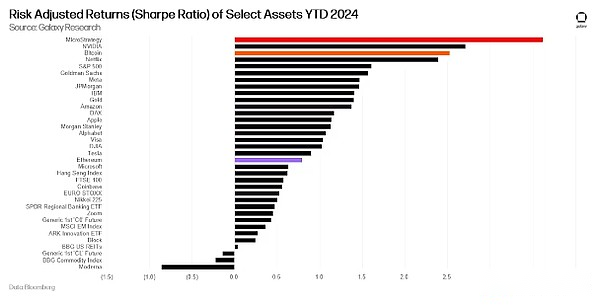
4. At least one top wealth management platform will announce recommendations of 2% or higher Bitcoin configurations.For various reasons, including maturity, internal education, compliance requirements, etc., no large wealth management companies or asset management companies have officially added Bitcoin allocation recommendations to the investment advice model portfolio.This will change in 2025, which will further increase the U.S. dollar traffic and asset management scale.
5. Five Nasdaq 100 index companies and five countries will announce that they have added Bitcoin to their balance sheet or sovereign wealth funds.Whether for strategic, portfolio diversification or trade settlement reasons,Bitcoin will all start to find a place on the balance sheets of major businesses and sovereign allocators.Competition among nation-states, especially non-aligned countries, countries with large sovereign wealth funds, and even countries hostile to the United States, will drive adoption of strategies to mine or otherwise acquire Bitcoin.
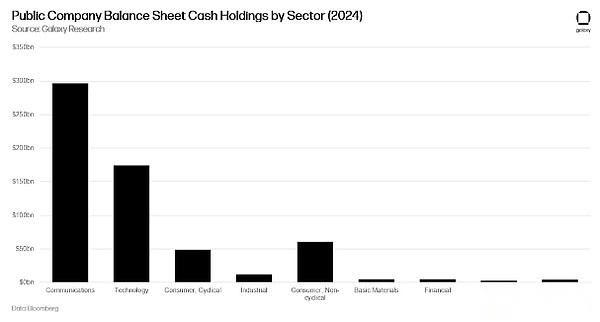
6. Bitcoin developers will reach a consensus on the next agreement upgrade in 2025.Since 2020, Bitcoin core developers have been arguing about what operations can safely enhance transaction programmability.As of December 2024, the two most supported pending operations for transaction programmability are OP_CTV (BIP 119) and OP_CAT (BIP 347).Since the birth of Bitcoin, reaching consensus on soft forks is a time-consuming and rare feat, including OP_CTV, OP_CSFS, and/or OP_CAT -Gabe Parker in the next soft fork upgrade.
7. More than half of the top 20 publicly traded Bitcoin miners by market value will announce their transformation into hyperscale enterprises, artificial intelligence or high-performance computing companies or partnerships with them.The growing demand for AI computing will lead to increasingly transforming and building HPC infrastructure or juxtaposing HPC infrastructure with Bitcoin mines.This will limit the year-on-year growth of the hash rate, which will reach 1.1 zetahash by the end of 2025.
8. Bitcoin DeFi (that is considered to be the total amount of BTC locked in DeFi smart contracts and deposited into the staking protocol) will almost double by 2025.As of December 2024, more than $11 billion worth of packaged BTC was locked in DeFi smart contracts.It is worth noting that over 70% of locked BTC is used as collateral for lending agreements.With Babylon, the largest staking agreement in Bitcoin, there are approximately $4.2 billion in additional deposits.The Bitcoin DeFi market is currently worth US$15.4 billion and is expected to expand significantly in multiple areas by 2025, including the existing DeFi protocol on Ethereum L1/L2, the new DeFi protocol on Bitcoin L2, and staking layers such as Babylon.The current market doubling may be driven by several key growth factors: cbBTC supply increased by 150% year-on-year, WBTC supply increased by 30%, Babylon’s TVL reached $8 billion, and the new Bitcoin L2 achieved $4 billionDeFi TVL.
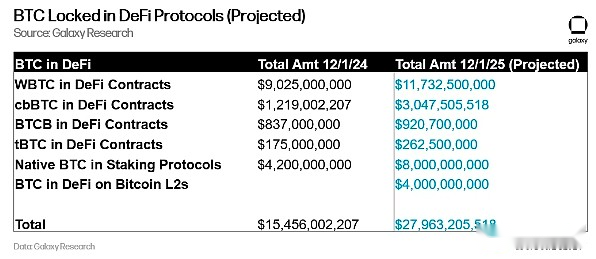
Ethereum
9. By 2025, Ethereum will be trading at more than $5,500.The easing of regulatory resistance to DeFi and staking will drive Ethereum to hit new all-time highs in 2025.The new partnership between DeFi and TradFi, perhaps in a new regulatory sandbox environment, will eventually allow traditional capital markets to seriously try public blockchain, Ethereum and its ecosystem to see the largest share of use.Enterprises will increasingly try their own layer 2 networks, mainly based on Ethereum technology.Some games that utilize public blockchains will find a point of fit between products and markets, and NFT transaction volume will rebound sharply.
10. The staking rate of Ethereum will exceed 50%.The Trump administration may provide clearer regulation and guidance to the crypto industry.Demand for pledges will continue to rise next year, and may exceed half of Ethereum’s circulating supply by the end of 2025, prompting Ethereum developers to consider changes in online monetary policy more seriously.More importantly, the increase in staking will drive greater demand and value through Ethereum staking pools such as Lido and Coinbase, as well as restaking agreements such as EigenLayer and Symbiotic.
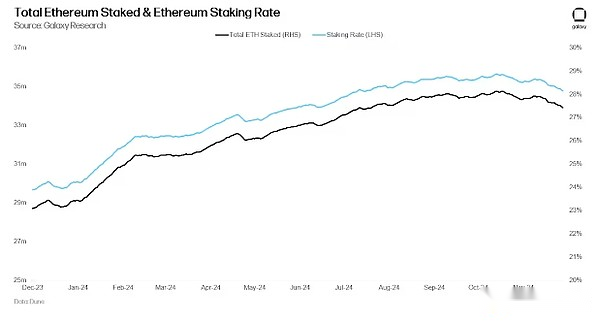
11. The ETH/BTC ratio is one of the most popular currency pairs among all cryptocurrencies., ETH/BTC ratio has been on a dangerous downward trend since Ethereum’s “merger” upgrade in September 2022 shifted to proof of stake.However, the expected regulatory shift will help Ethereum and its application layer, especially DeFi, reignite investors’ interest in the world’s second largest value blockchain network.
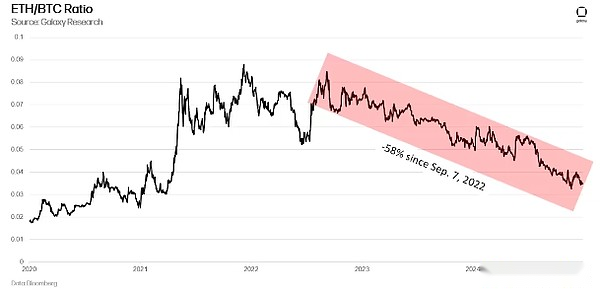
12. By 2025, L2 as a whole will generate more economic activity than Alt L1.L2 expenses as a percentage of Alt L1 expenses (currently in the medium single digits) will exceed 25% of the total Alt L1 expenses by year end.L2 will approach expansion restrictions early this year, resulting in frequent surges in transaction fees, which will require changes to Gas restrictions and Blob market parameters.However, other technical solutions (e.g., Reth clients or altVMs, such as Arbitrum Stylus) will provide a higher efficiency for the summary to keep transaction costs at available levels.
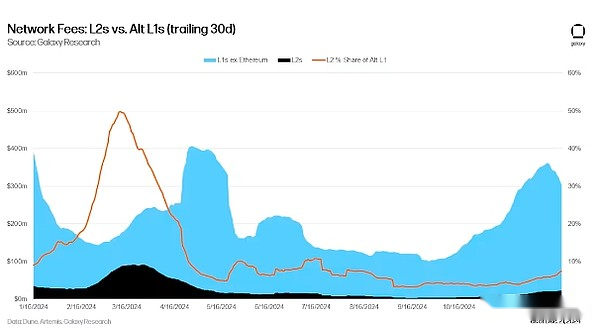
Decentralized Finance (DeFi)
13. DeFi will enter the “Bonus Era” as on-chain applications will allocate at least $1 billion to users and token holders through vault funds and revenue sharing.As DeFi regulation becomes clearer, value sharing for on-chain applications will expand.Applications such as Ethena and Aave have initiated discussions or adopted proposals to implement their fee switches, the infrastructure to allocate value to users.Other protocols that previously rejected such mechanisms, including Uniswap and Lido, may reconsider their position due to regulatory clarity and competitive dynamics.A loose regulatory environment and increased on-chain activity combined suggest that the agreement may conduct repurchase and direct revenue sharing at a higher rate than previously observed.
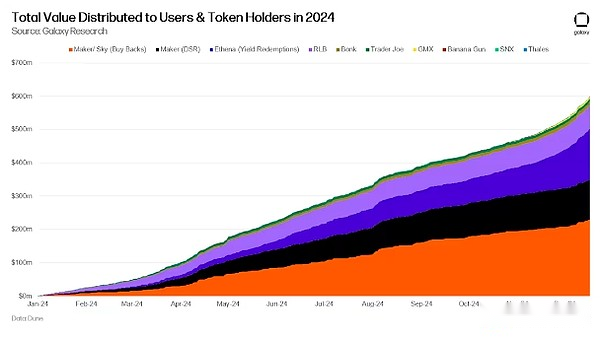
14. On-chain governance will recover, and the application will try future governance models.The total number of active voters will increase by at least 20%.On-chain governance has traditionally faced two problems: 1) lack of participation and 2) lack of voting diversity, and most proposals are passed by overwhelmingly.However, easing of regulatory tensions has been a limiting factor in on-chain voting, and Polymarket’s recent success suggests that both points will improve in 2025.By 2025, applications will begin to shift from traditional governance models to future governance models, improving voting diversity, and regulatory tailwinds will promote governance participation.
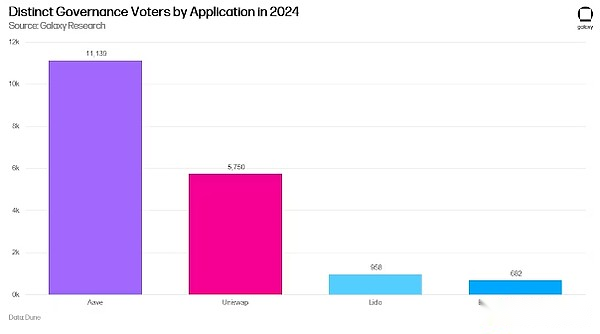

Banks and stablecoins
15. The US Currency Supervision Agency (OCC) will create a way for banks in various countries to custody digital assets, guiding the world’s four major custody banks to provide digital asset services: Bank of New York, State Street, JPMorgan Chase and Citibank.
16. TradFi partners will support the launch of at least 10 stablecoins.From 2021 to 2024, stablecoins have experienced rapid growth, and the number of projects has reached 202, including several projects closely related to Traditional Finance (TradFi).In addition to the number of stablecoins launched, its transaction volume growth has also exceeded major payment networks such as ACH (about 1%) and Visa (about 7%).In 2024, stablecoins will increasingly be integrated into the global financial system.For example, FV Bank, which is licensed in the United States, now supports direct stablecoin deposits, while the three major Japanese banks work with SWIFT through Project Pax to achieve faster and more cost-effective cross-border capital flows.Payment platforms are also building stablecoin infrastructure.For example, PayPal launched its own stablecoin PYUSD on the Solana blockchain, while Stripe acquired Bridge to support stablecoins natively.Additionally, asset management companies such as VanEck and BlackRock are working with stablecoin projects to build a foothold in the field.Looking ahead, with increasingly clear regulation, TradFi participants are expected to integrate stablecoins into their operations to maintain a leading trend, while pioneers are ready to gain an advantage by building infrastructure for future business development.
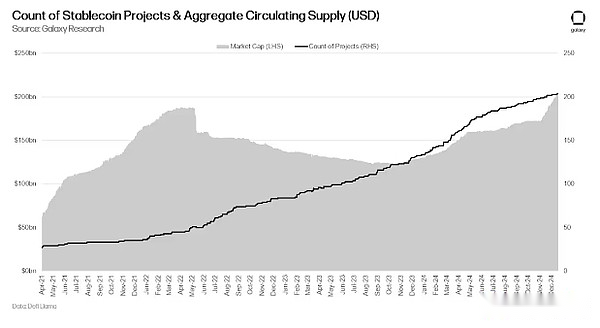
17. By 2025, the total supply of stablecoins will double to more than US$400 billion.Stablecoins are increasingly finding markets for products suitable for payment, remittance and settlement.The increasing regulatory oversight of existing stablecoin issuers as well as traditional banks, trusts and deposit institutions will lead to an explosive growth in the supply of stablecoin in 2025.
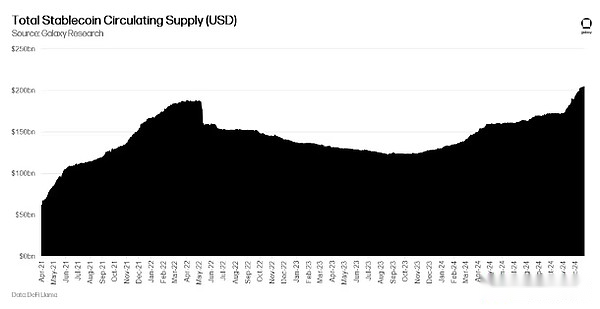
18. Tether’s long-term market dominance will fall below 50%, challenged by revenue alternatives such as Blackrock’s BUIDL, Ethena’s USDe, and even USDC Rewards paid by Coinbase/Circle.As Tether internalizes earnings revenue from USDT reserves to fund portfolio investments, marketing spending by stablecoin issuers/protocols to deliver revenue will shift existing users from Tether to new users to their earnings solutions.USDC’s rewards to users’ Coinbase exchanges and wallet balances will become a strong link that will drive the development of the entire DeFi sector and may be integrated by fintech companies to achieve new business models.In response, Tether will begin passing on the revenue held by collateral to USDT holders, and may even offer new competitive earnings products such as Delta neutral stablecoins.

Investment and Policy
19. The total investment in cryptocurrency venture capital will exceed US$150 billion, an increase of more than 50% year-on-year.Given the decline in interest rates and increased transparency in cryptocurrency regulation, the surge in venture capital activity will be driven by increased interest in risky activity by allocators.Crypto Venture Capital Financing has historically lagged behind the broader cryptocurrency market trends and will have a degree of “catching up” in the next four quarters.
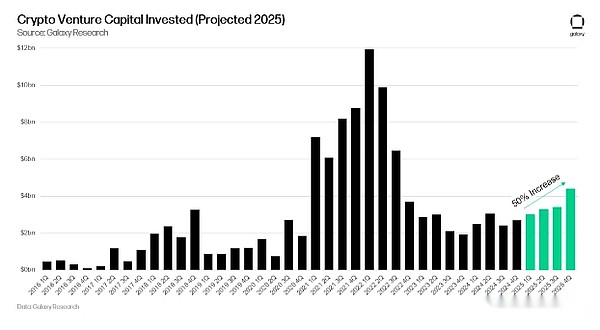
20. Stablecoin legislation will be passed in both the Senate and the House of Representatives and signed by President Trump in 2025, but the market structure legislation will not.The legislation formalized and established by the formalization of the registration and supervision system of U.S. stablecoin issuers will be passed with bipartisan support and signed into law by the end of the year, coupled with the expected easing of restrictions on banks, trusts and deposit institutions, whichThis will lead to a significant increase in stablecoin adoption rates.Market Structure – Develop registration, disclosure and supervision requirements for token issuers and exchanges, or adjust existing rules for the SEC and CFTC to include them – is more complex and will not be completed, adopted and signed in 2025Become the law.
21. The U.S. government will not buy Bitcoin in 2025, but will use the Bitcoin it already holds to create inventory, and some actions will be taken within departments and institutions to review the expanded Bitcoin reserve policy.
22. The U.S. Securities and Exchange Commission will investigate the first so-called “special purpose brokerage dealer” Prometheum.A previously unknown brokerage dealer suddenly emerged, just in line with the SEC’s overall view.Chairman Gensler’s perception of the status of digital asset securities has attracted attention in 2023, especially when the unknown company received its first new category brokerage dealer license.According to FINRA records, the CEO was condemned in Congress by Republican members of the House Financial Services Committee.Republicans called on the Justice Department and the SEC to investigate Prometheum’s “relationship with China”, while others pointed to violations in its fundraising and reporting.Regardless of whether Prometheum is investigated or not,Special Purpose Broker Dealer License is likely to be repealed in 2025.
23. Dogecoin will eventually reach USD 1, and the world’s largest and oldest Meme coin will have a market value of USD 100 billion.However, Dogecoin’s market value will be overshadowed by the government’s Department of Efficiency, which will determine and successfully implement the U.S. fiscal budget that exceeds Dogecoin’s high water market value in 2025.








